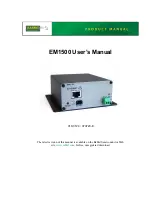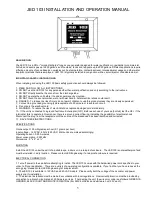
AC15QTP And AC20QTP Operations Manual....
34
6.5
REMOTE COMMUNICATIONS
The converter can be controlled remotely and be queried for alarm, electrical, and status data
through its RS-232C port. The port’s hardware configuration is by default RS-232C unless
modified by the inclusion of the Modbus Option—which converts the default hardware protocol
to the RS-485 standard via a din-rail mounted converter/optical-isolator.
The two software protocols supported by the converter are SCPI and Modbus. Please contact an
ASEA Power Systems authorized distributor or the factory for additional information and
comprehensive command/query listings.
The Baud Rate and fixed serial port settings can be viewed in the REMOTE INTERFACE
CONFIGURATION DISPLAY (as depicted below) by pressing the SYSTEM STATUS
(5)
and
F3
(13)
buttons simultaneously. The software protocol in use is indicated in the lower-right
corner (SCPI or Modbus). The software protocol is auto-detected by the converter based on the
incoming command/query formatting.
The Baud Rate can be increased by pressing the F1
(13)
button, and decreased by pressing the F2
(13)
button. Press the F3
(13)
button to change the Node Id while the software protocol is set for
Modbus mode. Press the F4
(13)
button to manually move between the SCPI and Modbus
modes.
Press the SYSTEM STATUS
(5)
button to save settings and exit.
Standard baud rates are 1200, 2400, 4800, 9600, 19200, and 38400 where 19200 is the standard
for communication with ASEA Power Systems Touch Screens.
REMOTE INTERFACE CONFIGURATION
BAUD: 19000 8-DATA BITS,1 START,1 STOP
PARITY: NONE EOS: CR/LF DEVICE: DCE
HANDSHAKING: NONE SCPI
REMOTE INTERFACE CONFIGURATION
BAUD: 19000 8-DATA BITS,1 START,1 STOP
PARITY: NONE Node Id: 3 DEVICE: DCE
HANDSHAKING: NONE Modbus
















































